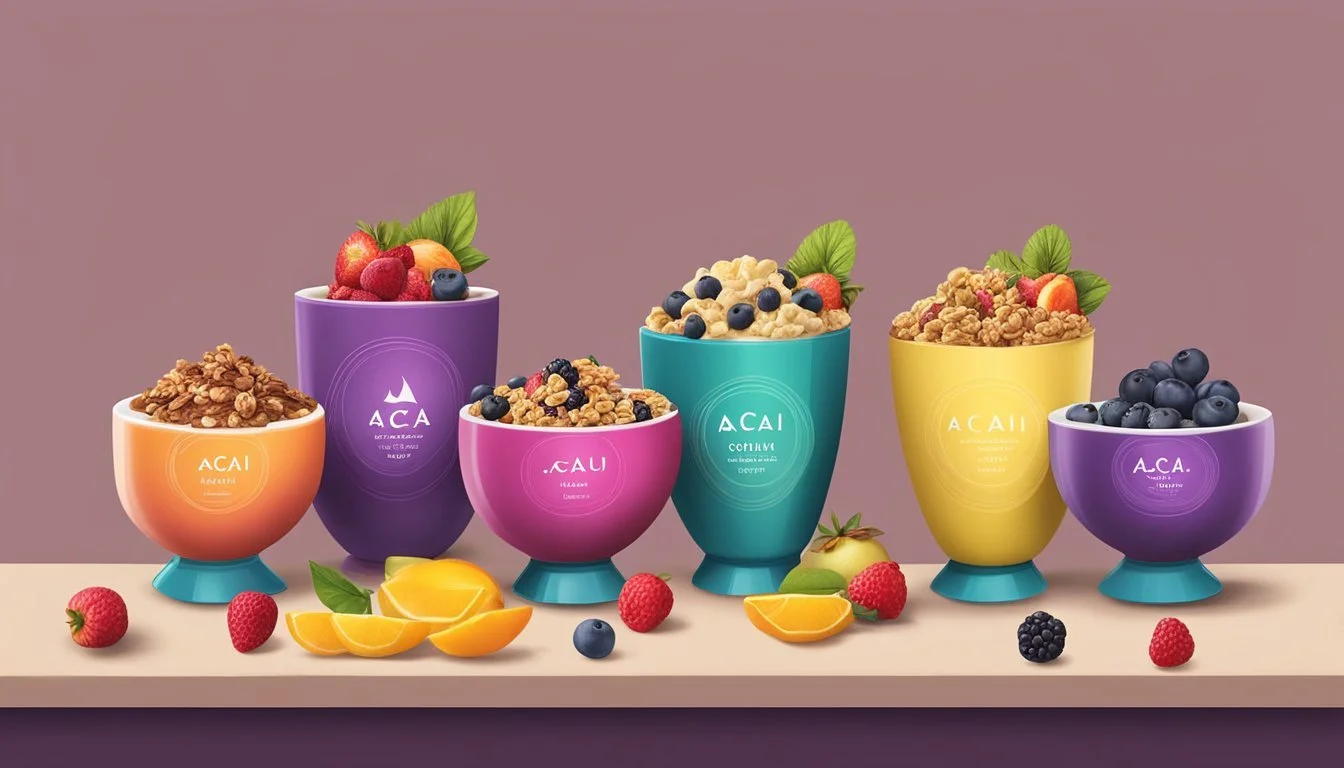Are Acai Bowls a Superfood Breakfast or a Sugary Treat?
Unpacking the Health Hype
Acai bowls have gained tremendous popularity as a trendy breakfast option, often hailed as a superfood powerhouse. With their vibrant color and rich texture, they present a visually appealing and potentially nutritious start to the day. Composed primarily of pureed acai berry, a fruit from the Amazon, these bowls are frequently lauded for their antioxidant content. They are commonly complemented with an assortment of toppings such as fruits, nuts, seeds, and granola, which can enhance both their flavor profile and nutritional value.
However, the health impact of acai bowls is not solely determined by the acai berry itself but also by the composition of the entire dish, including the types and quantities of added toppings and sweeteners. While the base fruit may offer health benefits, the total nutritional content can vary widely. Commercially prepared acai bowls, in particular, may contain large quantities of added sugars and calories, raising questions about their overall healthfulness.
The perception of acai bowls as either a superfood-packed breakfast or a sugary treat is influenced by these elements. Health-conscious consumers often seek meals that provide energy and essential nutrients without excessive sugar intake. Therefore, it's crucial to consider the individual ingredients and their proportions in an acai bowl to fully assess its nutritional profile and its role in a balanced diet.
Understanding Acai Bowls
Acai bowls have surged in popularity, celebrated both for taste and purported health benefits. At the heart of an acai bowl are acai berries, tiny, dark purple fruits hailing from the tropical Amazon region. Touted as a superfood, they are rich in antioxidants and fiber, boasting more antioxidants than blueberries.
These bowls typically feature a thick blend of acai puree as the base. The puree often combines other fruits and sometimes sweeteners or juice, which can contribute to the sugar content of the bowl. The consistency of the acai mix resembles that of a smoothie or soft-serve ice cream and is served cold.
Toppings play a pivotal role in an acai bowl's health profile. Common additions include:
Fresh fruits (banana, kiwi, strawberries, blueberries)
Granola or nuts
Shredded coconut
A drizzle of honey or syrup
Nutritional Considerations:
Antioxidants: High content from acai aids in combating oxidative stress.
Sugar: Can be high, depending on fruit used and added sweeteners.
Calories: Bowls can be calorie-dense, with some commercial options exceeding 400 calories.
The bowls can be a nutritious choice, providing essential nutrients and satiety through a mix of fruits and fiber. However, the sugar content and overall calorie count require careful consideration, as these factors can transform a healthful bowl into a sugary indulgence. For a balanced approach, one should consider portion sizes, minimize added sugars, and look for a mix of protein and healthy fats to pair with the carbohydrate-rich acai base.
Nutritional Profile
Acai bowls offer a rich mix of nutrients essential for health, though their overall nutritional value can vary based on specific ingredients. Prominent in fiber, antioxidants, and healthy fats, they can be a nutrient-dense choice for a meal when prepared with attention to sugar content.
Vitamins and Antioxidants
Acai berries provide a significant amount of antioxidants, which are compounds known to counteract the damaging effects of free radicals in the body. Vitamin C and vitamin A are the prominent vitamins found in acai, both of which support immune function and skin health.
Vitamin C: Vital for the repair of all body tissues
Vitamin A: Important for vision and organ function
Minerals and Healthy Fats
The tiny acai berry is also a source of important minerals like calcium and magnesium, which are crucial for bone health and metabolic functions. Acai bowls often contain added seeds and nuts, which contribute healthy fats. These fats are essential for brain health and can help in reducing inflammation.
Calcium: Essential for bones and teeth
Magnesium: Supports hundreds of biochemical reactions in the body
Healthy Fats: Come from additions like nuts and seeds
Fiber and Protein Content
Fiber is abundant in acai bowls, especially if they include toppings such as fruits and granola, aiding in digestion and prolonging satiety. Protein content can be variable; adding ingredients like Greek yogurt or a scoop of protein powder can boost the protein levels, which is vital for tissue repair and muscle growth.
Fiber: Aids in digestion and helps maintain a feeling of fullness
Protein: Important for building and repairing tissues
Benefits and Health Considerations
Understanding the health benefits and considerations of acai bowls is crucial to determining whether they are a superfood breakfast or a sugar-laden treat. Key factors include the nutrient content, impact on weight, and the potential for added sugars to offset benefits.
Health Benefits
Acai bowls are anchored by the acai berry, renowned for its antioxidant properties. Antioxidants are vital for combating free radicals, which contribute to cell damage and aging. Regular consumption can support anti-aging efforts and bolster the immune system. Additionally, the natural energy boost from the nutrient-dense acai may help maintain steady energy levels throughout the day.
Antioxidant Activity: Rich in anthocyanins, acai helps protect cells.
Immune Support: Nutrients in acai may enhance immune function.
Energy: Natural sugars and fat in acai offer a healthy energy source.
Weight Management
The fiber in acai berries can aid in weight loss by increasing satiety, which might curb overeating. However, portion sizes and toppings largely dictate an acai bowl's suitability for weight management. Users should be mindful to optimize the ingredient profile:
Weight Loss: High-fiber acai can reduce appetite.
Weight Gain Risks: Large portions and sugary toppings increase calorie count.
Portion Control: Moderate bowl sizes to manage calorie intake.
Potential Drawbacks
The health benefits of acai bowls are sometimes compromised by added sugars and calorie-dense toppings. Excess sugars can prompt cravings and contribute to weight gain. Additionally, unregulated portion sizes can lead to inadvertent overconsumption of calories.
Added Sugars: Some bowls have extra sugar, undermining health benefits.
Caloric Content: Bowls with numerous toppings can be high in calories.
Sweeteners and Toppings: Opt for natural sweeteners and nutrient-rich toppings to minimize drawbacks.
Components of Acai Bowls
Acai bowls comprise a nutrient-rich acai berry base and are garnished with a variety of toppings, from fruits to nuts, offering a mix of flavors and textures. They can be tailored with additional add-ins for extra nutrition or flavor, depending on individual preference.
The Acai Base
The foundational element of an acai bowl is the acai base. This is typically made from frozen acai berry puree or acai powder blended with a liquid such as water, juice, or milk alternatives. Recipes may vary, but the aim is to achieve a thick, smoothie-like consistency that can be eaten with a spoon.
Ingredients for Acai Base:
Acai berry puree or powder
Liquid (water, juice, or milk alternatives)
Optional sweeteners (like honey or dates)
Common Toppings
Toppings are crucial for adding taste and texture to acai bowls. They often consist of fruit and berries, such as sliced bananas, mango, papaya, pineapple, kiwi, blueberries, strawberries, and raspberries. Granola is another staple for a satisfying crunch, and for additional sweetness, a drizzle of honey or agave syrup is common.
List of Toppings:
Fresh Fruit: bananas, mango, papaya, pineapple
Berries: blueberries, strawberries, raspberries
Crunch: granola, nuts (almonds, walnuts), seeds (pumpkin, sunflower)
Sweeteners: honey, agave syrup
Additional Add-ins
For an extra boost of nutrition or to cater to specific dietary needs, there are several add-ins that can be included. Seeds like chia, hemp, or flaxseeds are popular for their omega-3 fatty acids. Nuts, including almonds and Brazil nuts, provide healthy fats and protein. Superfoods like goji berries, cacao nibs, or coconut flakes add unique flavors and additional antioxidants.
Optional Add-Ins:
Superfoods: goji berries, cacao nibs, coconut flakes
Seeds: chia seeds, hemp seeds, flaxseeds
Nuts: almonds, Brazil nuts
By selecting from these components, consumers have the freedom to create an acai bowl that can either lean towards a nutrient-packed breakfast or a sweeter, more indulgent treat.
Customizing Your Acai Bowl
creating a customizable acai bowl allows individuals to cater to their dietary preferences, whether aiming for a superfood-rich breakfast or a lower-sugar treat. By choosing the right sweeteners, dairy or non-dairy bases, and nutrient-dense toppings, one can tailor their acai bowl to be as healthy as they desire.
Alternatives for Sweeteners
To reduce sugar intake, one can opt for natural sweeteners such as ripe bananas or a drizzle of honey. For a vegan and lower glycemic index option, substituting with monk fruit sweetener or organic stevia can satisfy sweetness cravings without adding refined sugars. Unsweetened acai is another avenue to ensure control over the bowl's sugar content.
Dairy and Non-Dairy Options
Acai bowls can be made creamy with a variety of dairy or dairy-free bases. Traditional yogurt or Greek yogurt provides a thick texture and a protein boost. For a dairy-free or vegan bowl, almond milk, coconut milk, and soy milk are great alternatives that offer varying flavors and creaminess. Using plant-based yogurts is also an effective way to keep the recipe vegan and potentially gluten-free.
Protein and Fiber Boosters
To transform an acai bowl into a more filling and nutritious meal, incorporating protein powder, hemp seeds, or chia seeds can significantly up the protein content. Adding almond butter or peanut butter not only contributes healthy fats and proteins but also enhances the bowl's flavor profile. For a fiber increase, a sprinkling of nuts, gluten-free granola, or fresh fruit such as kiwi and berries can provide the necessary dietary fiber for digestive health.
The Role of Acai Bowls in a Balanced Diet
Acai bowls can serve as a nutritious breakfast option provided they are prepared with a focus on portion control and balanced ingredients. The base of an acai bowl is typically made from acai berry puree, rich in antioxidants and credited with offering a boost of energy due to its nutrient-dense nature. However, one must be cautious about the additional ingredients used to enhance taste and texture.
A balanced diet requires an understanding of the nutritional content of meals. Acai bowl toppings can significantly alter the health quotient; for instance, a heavy hand with granola, sweeteners, or sugary fruits can transform an acai bowl into a high-calorie treat.
Here is an optimal acai bowl composition that promotes a healthy balance:
Acai Puree: A fiber-rich base.
Fruits: Low-sugar options like berries add vitamins without excessive fructose.
Nuts/Seeds: A sprinkle for healthy fats and protein.
Sugar: Minimal to no added sugars; sweetness should come from natural fruit.
The nutritional value of an acai bowl varies, but a careful selection can yield the following benefits:
Nutrients Benefits Fiber Supports digestive health Antioxidants Combat oxidative stress Healthy Fats Contribute to heart health Vitamins/Minerals Essential for body function
In conclusion, individuals looking to integrate acai bowls into their balanced diet must consider the overall nutritional profile, ensuring adequate protein and avoiding the high-calorie pitfall. Consumed in moderation with a mindful approach to toppings, acai bowls can indeed be a vibrant, energy-boosting breakfast choice.
Preparing Acai Bowls at Home
Preparing acai bowls at home allows for control over ingredients, ensuring a balance between nutrition and sweetness. By selecting the right components, one can enjoy the health benefits of acai bowls as a superfood breakfast without excessive sugar.
Simple Recipes
A basic acai bowl recipe involves blending acai berry puree or powder with a liquid, such as coconut water or a dairy-free milk alternative, to create a thick smoothie base. Ingredients often include:
Frozen bananas for creaminess
Mixed berries for flavor and antioxidants
A scoop of protein powder or nut butter for added protein (optional)
Recipe steps typically include:
Blending the acai with liquid until smooth
Pouring into a bowl
Topping with fresh fruit, nuts, and seeds
Shopping for Ingredients
To prepare acai bowls, shop for:
Acai berry puree or powder: available online or in supermarkets.
Fresh fruit: bananas, strawberries, and blueberries.
Leafy greens: kale or spinach can be added for extra nutrients.
Toppings: granola, coconut flakes, and cacao nibs.
Consider:
Opting for unsweetened acai products to reduce sugar content.
Purchasing organic ingredients when possible for enhanced health benefits.
Acai Bowl Variations
Different variations cater to different dietary preferences:
Vegan acai bowls: Utilize plant-based milk and vegan protein powder.
Tropical acai bowls: Incorporate tropical fruits like mango and pineapple.
Green acai bowls: Blend in spinach or kale for extra greens.
Each variation follows a similar method: blend the base, pour into a bowl, and customize with toppings. Creativity is encouraged, and one can experiment with various combinations to suit personal taste preferences while maintaining nutritional integrity.
Popular Acai Bowl Brands and Outlets
Acai bowls have gained significant traction as both a health food and a trendy treat. The following information presents a snapshot of where consumers can find these berry-based bowls at popular brands and through various service outlets.
Brick-and-Mortar Locations
Brazil: The birthplace of the acai bowl, Brazil remains a hub for authentic acai experiences. Local eateries and beachfront vendors often serve up traditional versions of the dish, garnished with fresh fruit and granola.
Jamba Juice: As a well-known brand in the United States, Jamba Juice offers acai bowls as part of their menu. Their version combines açaí juice with soymilk, and an array of toppings, such as bananas, strawberries, and granola. Customers have the convenience of dining in or taking their bowls to go at multiple storefronts across the country.
Additional Notable Outlets:
Health Food Cafes: In major cities, a variety of health food cafes have popularized acai bowls, often focusing on organic ingredients.
Smoothie Shops: Many smoothie shops have included acai bowls in their offerings, customizing them with a range of toppings to appeal to health-conscious consumers.
Online and Delivery Services
Online retailers and delivery services have made accessing acai bowls more convenient. Shoppers can find frozen acai puree packs for at-home preparation or order ready-to-eat bowls through food delivery apps.
Amazon: Frozen acai packets are available for purchase, enabling at-home creations.
Meal Delivery Services: Some services specialize in delivering premade acai bowls directly to consumers' doors, maintaining quality and taste.
Supermarkets Online Shopping: Major grocery chains offer a selection of acai products online, facilitating easy pick-up or delivery options.
The access to acai bowls has expanded significantly with the advent of online shopping and dedicated delivery services, reflecting the product's integration into mainstream food culture.
Frequently Asked Questions about Acai Bowls
Acai bowls are trendy, but understanding their true nutritional profile and customization options is crucial for health-conscious individuals. These questions address the core health considerations related to acai bowls.
Nutritional Value
Acai berries deliver antioxidants, fiber, and healthy fats. A standard acai bowl blend without added sugars typically contains around:
Total Carbohydrates: 4 g
Dietary Fiber: 3 g
Protein: 1 g
Total Fat: 5 g (with 1 g saturated fat)
Sodium: 10 mg
The vitamin and mineral content in acai bowls largely depends on the additional fruit and toppings chosen.
Suitability for Dietary Restrictions
Acai bowls can cater to various diets:
Vegan: Naturally vegan as they are plant-based.
Dairy-free: Generally dairy-free unless yogurt or other dairy toppings are added.
Gluten-free: Ensure granola or additional toppings are gluten-free.
It's important for consumers to verify ingredients to ensure alignment with dietary needs.
Choosing Healthy Toppings
Adding fruits, nuts, and seeds can increase the nutrient content of an acai bowl. Consider these options:
Fruits: Add bananas, blueberries, or strawberries for fiber and vitamins.
Nuts/Seeds: Almonds, chia seeds, or flaxseeds contribute protein and healthy fats.
Toppings to avoid: Granola or sweeteners that can be high in added sugars and calories.
Choosing the right toppings can transform an acai bowl from a sugary treat to a nutrient-dense meal.








